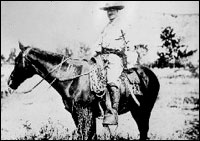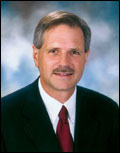
From Badlands to worse.
Photo: NPS.
To Theodore Roosevelt, a man who battled chronic asthma, the remote Badlands of North Dakota were as beloved for their fresh air as for their dramatic views and big game. “Wildflowers and sagebrush spiced the clean, dry North Dakotan breeze. Roosevelt’s asthmatic lungs rejoiced in this air, as did his soul in the sheer size and emptiness of the landscape,” Edmund Morris wrote in The Rise of Theodore Roosevelt. Now ol’ T.R. is probably spinning — or wheezing — in his grave.
Just before Valentine’s Day this year, the Bush administration gave the North Dakota electric industry a sweetheart deal, agreeing to a plan that will pave the way for new coal-fired power plants to be built in the state near Theodore Roosevelt National Park — the same picturesque terrain where its namesake discovered his calling as the godfather of the American conservation movement.
Since 1999, the U.S. EPA and North Dakota officials have sparred over air quality in the park, with the EPA saying that pollution has exceeded federal clean-air standards and state and industry representatives trying to refute the charge. According to state air-evaluation reports from 1999, the region’s power plants were pumping out about 66,000 tons more sulfur dioxide each year than permitted under federal rules. In 2000, EPA officials in Region 8, which includes North Dakota, confirmed this finding.

Teddy, back in cleaner days.
Photo: NPS.
But suddenly, as of Friday, North Dakota’s power-plant emissions have been deemed acceptable by the Bush EPA — despite the fact that no significant efforts have been made to reduce pollution in the state. What gives? Well, what always gives when industry demands run up against pollution standards these days? The standards. The EPA agreed to let North Dakota change the methods it uses to estimate air pollution, altering the criteria within its pollution modeling software that dictate what baseline years are used and how the pollution data is averaged.
State and industry officials argue that the revised models should produce results that are more consistent with those of large air-monitoring equipment installed within the park — equipment which consistently registers lower pollution levels.
But according to an EPA Region 8 official who asked to remain anonymous, the results from that equipment are not necessarily to be trusted: “There are only two air monitors within a sprawling 70,000 acres of territory, and the data they produce is hardly reliable.” The official contends that the analysis models the state has been using, which employ data gathered at more than 100 points in the park from smaller, mobile equipment, are more accurate.

Gov. John Hoeven
Photo: N.D. Governor’s Office.
Still, despite objections from Region 8 officials, EPA headquarters in Washington, D.C., last week announced a deal with North Dakota’s Republican governor, John Hoeven. At a press conference last Friday, Hoeven announced the agreement with an assurance that the new modeling system will enable the state to build additional power plants. “It sets the stage for new investments in our energy industry and real progress in our rural communities,” Hoeven beamed.
David Glatt, head of environmental health at North Dakota’s Health Department, asserted that the new model will assess emissions more accurately than the old one, but local environmentalists say they don’t trust Glatt and his colleagues.
“These [state officials] have proven themselves to be a devious bunch — they have cooked the books in the past to get around clean-air requirements,” said Mary Mitchell of the Dakota Resource Council, a local group which has sued the EPA for not upholding its responsibility to limit pollution in North Dakota. “We have evidence that after the original pollution reports were made in 1999, the industry and the state made 14 separate efforts to redo the reports with different ‘modeling scenarios’ to make it look like they were complying. And now they’re getting permission to officially change the methodology.” Reed Zars, the lawyer representing the Dakota Resource Council, said the glad-handing between the Bush EPA and North Dakota smacks of “a political fix: We know to a certainty that this deal was imposed on the professionals and scientists from above in Washington at the EPA. Regional staff at EPA have consistently taken a view that is 180 degrees different than what’s expressed by the powers that be.”
Frank O’Donnell, executive director of the Clean Air Trust, said his real concern is not merely how this will affect North Dakota, but the implications for parks nationwide. “The Clean Air Act specifically states that pristine areas of the United States … should be kept pristine,” he said. “But now that one [national] park is getting away with a weaker monitoring system, it’s only a matter of time before the other states catch on.” Sure enough, Kerrigan Clough, the EPA’s deputy regional administrator in Region 8, has told the press that five other states in the region — Colorado, Montana, South Dakota, Utah, and Wyoming — want to follow North Dakota’s lead. “They’re lining up,” said an official who works under Clough and asked to remain anonymous. “We fully expect these states will also want new methods for calculating pollution [in their parks].”
Soon it won’t just be Roosevelt, but Edward Abbey, David Brower, and countless other wildland crusaders spinning and coughing in their graves.

